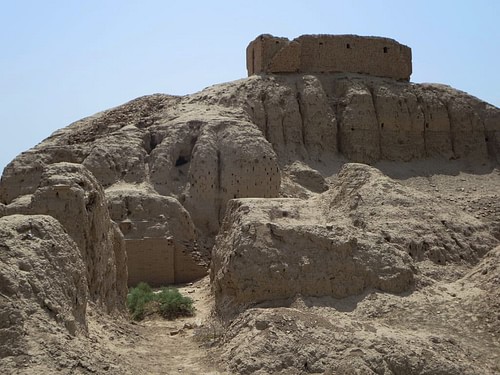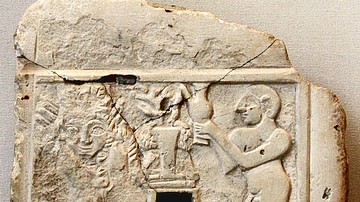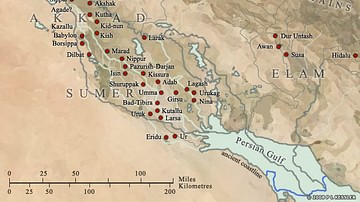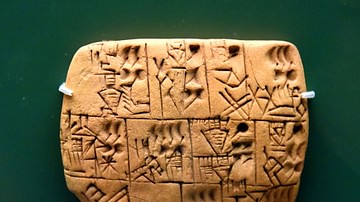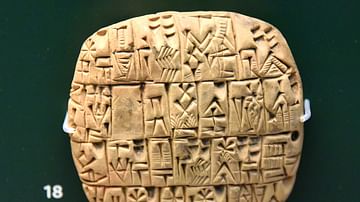The Kesh Temple Hymn (c. 2600 BCE) is the oldest work of literature in the world, sometimes referenced as the oldest extant religious poem. It is a Sumerian praise song to the goddess Ninhursag and her temple in the city of Kesh, composed in eight sections of "houses" progressing from the temple's foundation to a cautionary welcome.
The work is often referenced in connection to The Instructions of Shuruppag, usually dated to c. 2000 BCE but possibly as old as c. 2600 BCE, making it contemporaneous with the hymn. Shuruppag, depending on its dating, is either the oldest work of philosophical literature or among the oldest extant and, with the hymn, provides a picture of the religious/philosophical life of ancient Sumer. The cuneiform tablet of the hymn was discovered in the ruins of Nippur (in modern-day Iraq) in the 19th century and first translated in 1909. Nippur was a well-known religious and intellectual center that supported a number of scribal schools, and the Kesh Temple Hymn was included in the educational curriculum as part of the Decad, the course of study for advanced students nearing graduation.
The hymn moves from the foundation of Kesh and its temple by the god Enlil through descriptions of the gods involved in its operation and upkeep, to the rites observed, and concluding with praise for the city and Ninhursag (given here as Nintud), the great Mesopotamian mother goddess. The hymn is thought to have influenced various passages and books of the Bible through imagery and symbolism as well as its form of praise, especially the Book of Genesis. The hymn is among the most famous works of Mesopotamian literature.
Commentary & Summary
Although some scholars have claimed that "Kesh" is simply an alternate form of the name of the city of Kish, most understand it as a separate city whose location has not yet been identified. Kish was one of the oldest cities in Sumer, dating from the Ubaid Period (c. 5000-4100 BCE), but was associated with Inanna, not Ninhursag, as its patron goddess. Inanna, early on, was paired with Enki, god of wisdom, who later became Ninhursag's consort, and so it is possible that worship of Inanna was replaced by devotion to Ninhursag and Kesh is referencing Kish, though this claim is not generally accepted, especially as veneration of Inanna at Kish continued through the Akkadian Period (2334-2218 BCE).
The hymn describes the majesty and operation of the temple of Kesh from its establishment by the god Enlil through eight "houses" each ending with a triad of rhetorical questions:
Will anyone else bring forth something as great as Kesh? Will any other mother ever give birth to someone as great as its hero Acgi? Who has ever seen anyone as great as its lady Nintud?
Acgi (also given as Asgi and Ashgi) was a son of Ninhursag and the astral/underworld god Sul-pa-e before the goddess became the consort of Enki. Acgi was a war god and seems to have been the patron of Kesh before Ninhursag assumed that role. The Kesh Temple Hymn may, in fact, have been a celebration of the cult of Ninhursag over that of Acgi, though the former god continued to be honored.
The first "house" describes the founding of Kesh by Enlil and its organization by Nisaba, goddess of writing and, earlier, of agriculture. The temple is said to be "rooted in the abzu", the primordial waters usually associated with the city of Eridu and the establishment of order. The second and third houses describe the temple, including statuary ("10 car" and "5 bur", bison, stags, sheep); the fourth, its offerings. The fifth describes how Acgi ("the hero") embellished the temple and lives there with his parents Nintud and Sul-pa-e (given here as Cul-pa-ed) and Urumac, the deity of the open plains (possibly another name for the god Sakkan). The sixth house again praises the appearance of the temple, and the seventh describes its operation. The poem ends with the admonition to "draw near – but do not draw near" – understood as an expression of awe in the presence of the divine similar to those in the Bible regarding sacred ground, holy places, and proper deference in entering the presence of a deity.
Text
The following is taken from The Literature of Ancient Sumer, translated by Jeremy Black et al., and from The Electronic Text Corpus of Sumerian Literature, translated by the same. Ellipses indicate missing words or lines, and question marks suggest an alternate translation for a word or phrase.
1-9: The princely one, the princely one came forth from the house. Enlil, the princely one, came forth from the house. The princely one came forth royally from the house. Enlil lifted his glance over all the lands, and the lands raised themselves to Enlil. The four corners of heaven became green for Enlil like a garden. Kesh was positioned there for him with head uplifted, and as Kesh lifted its head among all the lands, Enlil spoke the praises of Kesh.
10-20: Nisaba was its decision-maker (?); with its words she wove it intricately like a net. Written on tablets it was held in her hands: House, platform of the Land, important fierce bull! House Kesh, platform of the Land, important fierce bull! Growing as high as the hills, embracing the heavens, growing as high as E-kur, lifting its head among the mountains! Rooted in the abzu (2 mss. have instead: Colourful as the abzu), verdant like the mountains! Will anyone else bring forth something as great as Kesh? Will any other mother ever give birth to someone as great as its hero Acgi? Who has ever seen anyone as great as its lady Nintud?
21: The first house.
22-30: Good house, built in a good location, house Kesh, (some mss. add here: good house,) built in a good location, floating in the heavens like a princely barge, like a holy barge furnished with a ... gate, like the boat of heaven, the platform of all the lands! ... from the riverbank like a ... boat cabin! House roaring like an ox, bellowing loudly like a breed-bull! House in whose interior is the power of the Land, and behind which is the life of Sumer!
31-43: House, great enclosure, reaching to the heavens, great, true house, reaching to the heavens! House, great crown reaching to the heavens, house, rainbow reaching to the heavens! House whose platform extends into the midst of the heavens, whose foundations are fixed in the abzu, whose shade covers all lands! House founded by An, praised by Enlil, given an oracle by mother Nintud! House Kesh, green in its fruit! Will anyone else bring forth something as great as Kesh? Will any other mother ever give birth to someone as great as its hero Acgi? Who has ever seen anyone as great as its lady Nintud?
44: The second house.
45-57: House, 10 car at its upper end, 5 car at its lower end; house, 10 bur at its upper end, 5 bur at its lower end! House, at its upper end a bison, at its lower end a stag; house, at its upper end a wild sheep, at its lower end a deer; house, at its upper end a dappled wild sheep, at its lower end a beautiful deer! House, at its upper end green like a viper, at its lower end floating on the water like a pelican! House, at its upper end rising like the sun, at its lower end spreading like the moonlight; house, at its upper end a warrior mace, at its lower end a battle-axe; house, at its upper end a mountain, at its lower end a spring! House, at its upper end threefold indeed: Will anyone else bring forth something as great as Kesh? Will any other mother ever give birth to someone as great as its hero Acgi? Who has ever seen anyone as great as its lady Nintud?
58: The third house.
58A-58Q: (1 ms. adds here the following lines: House ... inspiring great awe, called with a mighty name by An; house ... whose fate is grandly determined by the Great Mountain Enlil! House of the Anuna gods possessing great power, which gives wisdom to the people; house, reposeful dwelling of the great gods! House, which was planned together with the plans of heaven and earth, ... with the pure divine powers; house which underpins the Land and supports the shrines! House, mountain of abundance which passes the days in glory; house of Ninhursag which establishes the life of the Land! House, great hillside worthy of the purification rites, altering (?) all things; house without whom no decisions are made! House, good ... carrying in its hands the broad Land; house which gives birth to countless peoples, seed which has sprouts! House which gives birth to kings, which determines the destinies of the Land; house whose royal personages are to be revered! Will anyone else bring forth something as great as Kesh? Will any other mother ever give birth to someone as great as its hero Acgi? Who has ever seen anyone as great as its lady Nintud?
58R: The ... house.)
59-73: It is indeed a city; it is indeed a city! Who knows its interior? The house Kesh is indeed a city! Who knows its interior? The heroes make their way straight into its interior and perform its oracle rites perfectly. Frisking cattle are gathered at the house in herds. The house consumes many cattle; the house consumes many sheep.
1 line unclear
Those who sit on daises bow their necks before it. It wears a crown to vie with the boxwood tree, it spreads out to vie with the poplar ...; it is (1 ms. adds here: growing) as green as the hills! Will anyone else bring forth something as great as Kesh? Will any other mother ever give birth to someone as great as its hero Acgi? Who has ever seen anyone as great as its lady Nintud?74: The fourth house.
75-86: House given birth by a lion, whose interior the hero has embellished (?)! House Kesh, given birth by a lion, whose interior the hero has embellished (?)! The heroes make their way straight into its interior. Ninhursag sits within like a great dragon. Nintud the great mother assists at births there. Cul-pa-ed the ruler acts as lord. Acgi the hero consumes the contents of the vessels (?). Urumac, the great herald of the plains, dwells there too. Stags are gathered at the house in herds. Will anyone else bring forth something as great as Kesh? Will any other mother ever give birth to someone as great as its hero Acgi? Who has ever seen anyone as great as its lady Nintud?
87: The fifth house.
88-102: House positioned over its foundations like a storm, like white bulls standing about on the plain; house founded by the prince, in praise on the tigi instrument! House in whose interior is the power of the Land, and behind which is the life of Sumer (some mss. have instead: it is filled with life); at whose gate is a lion reclining on its paws, at whose gate is the ruler who decides cases (?)! House at whose door is the Great Mountain without adversary; at whose bolt (some mss. have here instead: at whose bar) is a great frisking wild bull (some mss. add here the line: , at whose bolt is a beast ... a man (1 ms. adds here instead the line: , at whose ... is an awe-inspiring lion))! Whose well-founded storehouse is a corner of heaven, a corner of earth (1 ms. has here instead: Whose storehouse established as a household ...); whose terrace is supported by lahama deities; whose princely (1 ms. adds: great) wall ... the shrine of Urim! Will anyone else bring forth something as great as Kesh? Will any other mother ever give birth to someone as great as its hero Acgi? Who has ever seen anyone as great as its lady Nintud?
103: The sixth house.
103A-103K: (1 ms. (which uses a different numbering of the sections) adds here the following lines: House imbued with radiance, ... excellence! House ...! Lord Nudimmud in heaven and earth ... brickwork of the Land, brickwork ... grandly in the abzu. Terrace, relaxing abode, ... holy splendour ... of the people! House which is seemly for the foreign lands! Will anyone else bring forth something as great as Kesh? Will any other mother ever give birth to someone as great as its hero Acgi? Who has ever seen anyone as great as its lady Nintud?
103L: The eighth house.)
105-115: The holy house whose ... is the shrine, the holy house Kesh, whose ... is the shrine; the house whose lords are the Anuna gods, whose nuec priests are the sacrificers of E-ana! In the house the king places stone bowls in position; the good en priest ... holds the lead-rope dangling. The a-tu priests holds the staff; the ... brings the ... waters. The ... takes his seat in the holy place; the enkum priests bow down ... The pacec priests beat the drumskins; they recite powerfully, powerfully.
116-126: The bull's horn is made to growl; the drumsticks are made to thud. The singer cries out (1 ms. has instead: declaims) to the ala drum; the grand sweet tigi is played for him (some mss. have instead: the sweet tigi is well tuned). The house is built; its nobility is good! The house Kesh is built; its nobility is good! Its lady has taken a seat in its ... Ninhursag, its lady, has taken her seat in its ... Will anyone else bring forth something as great as Kesh? Will any other mother ever give birth to someone as great as its hero Acgi? Who has ever seen anyone as great as its lady Nintud?
127: The seventh house.
128-133: Draw near, man, to the city, to the city – but do not draw near! Draw near, man, to the house Kesh, to the city – but do not draw near! Draw near, man, to its hero Acgi – but do not draw near! Draw near, man, to its lady Nintud – but do not draw near! Praise be to well-built Kesh, O Acgi! Praise be to cherished Kesh and Nintud!
134: The eighth house.
Conclusion
It is possible the hymn was used in formal celebrations at the temple – as the hymn Enki in the E-kur (c. 2000 BCE) was at Nippur – or to commemorate the event of its founding, in the same way the poem Shulgi and Ninlil's Barge, written during the reign of Shulgi of Ur (2029-1982 BCE), celebrated the river journey and banquet he held for the divine couple Ninlil and Enlil in the 8th year of his reign. Festivals in ancient Mesopotamia always included the reading of some pertinent text and the Kesh Temple Hymn could have functioned in this same capacity.
It is certain, however, that the hymn was used in the edubba ("House of Tablets"), the Sumerian scribal school, as part of the Decad. After a student had mastered the basics of cuneiform, the next phase of the curriculum was simple compositions and then the Tetrad (a set of four works to be mastered) and the Decad (a set of ten). The Decad were the most difficult before the final compositions leading to graduation. The Kesh Temple Hymn would have served as a test of one's abilities while also impressing upon a student the majesty of the gods and the homes they chose to live in among their people.

